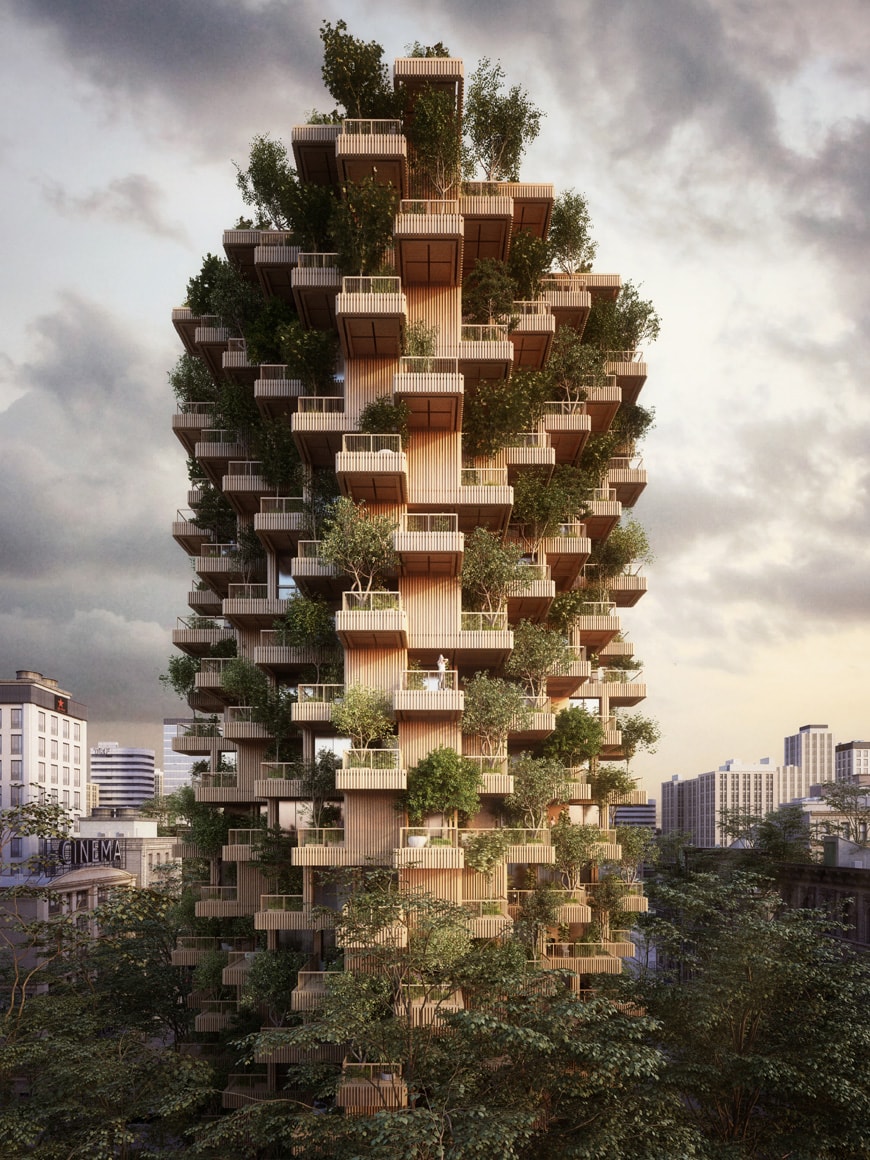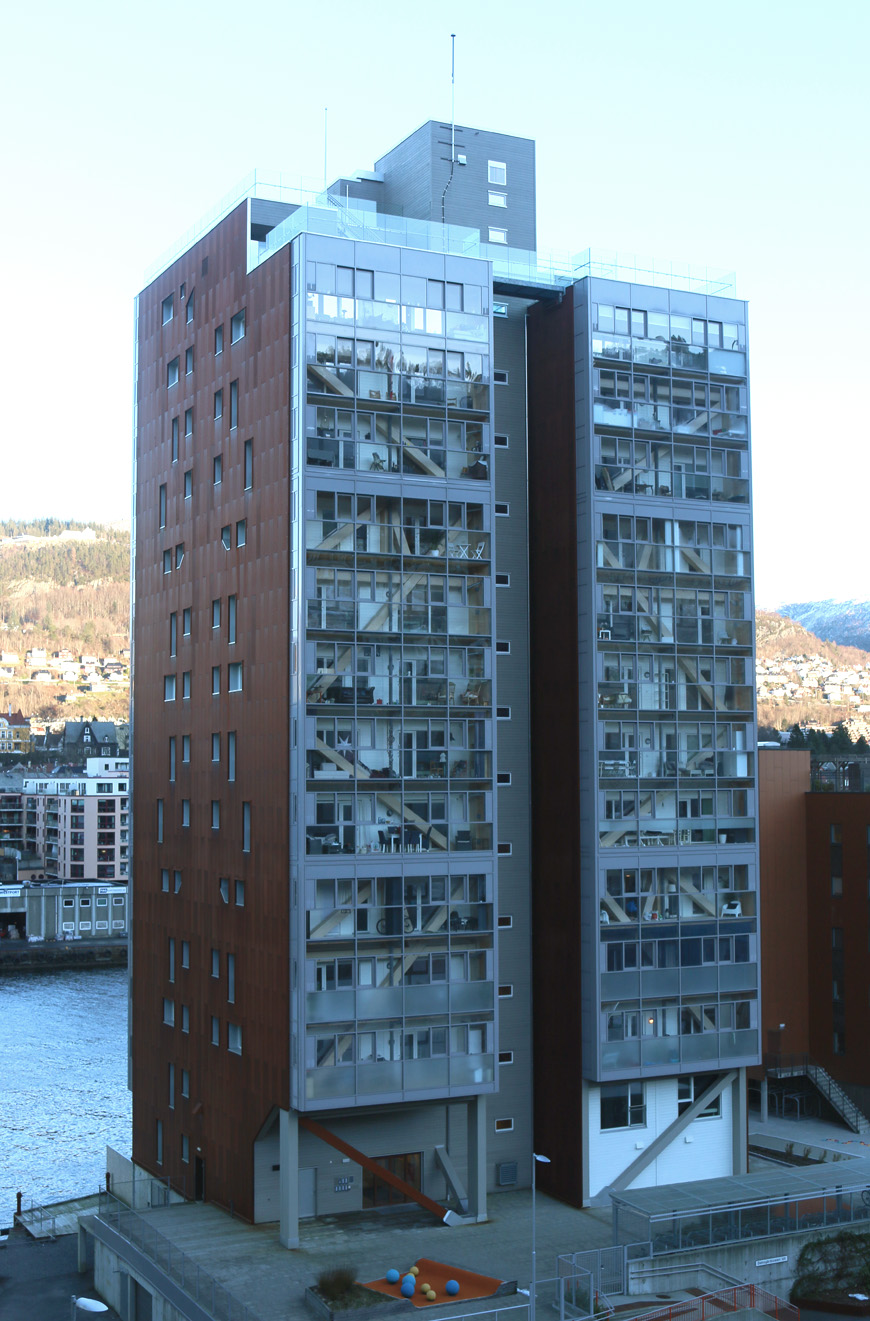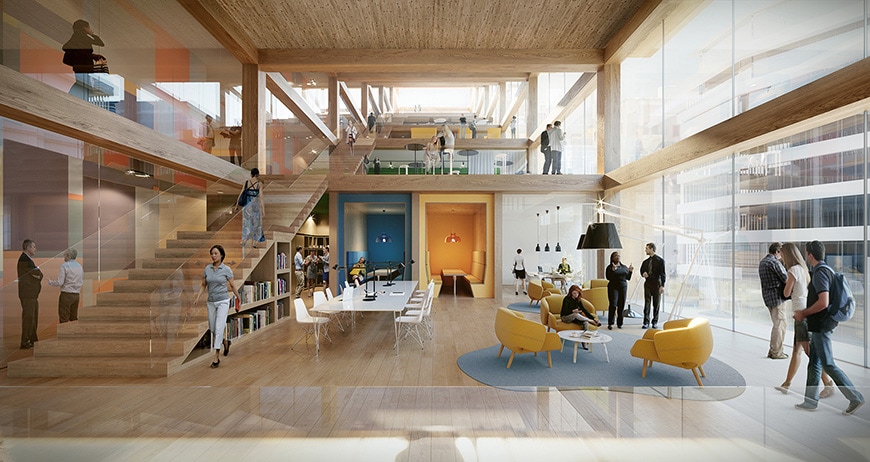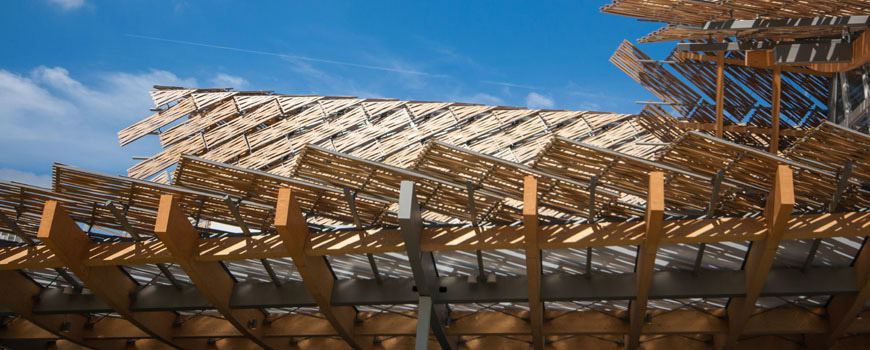CLT goes tall. The world’s tallest buildings in Cross Laminated Timber
images: see captions
The Mjøstårnet timber tower by Voll Arkitekter is currently the world’s tallest timber building.
Photo Øyvind Holmstad / Wikimedia Commons CC BY-SA 4.0
CLT goes tall. The world’s tallest buildings in Cross Laminated Timber
Cross Laminated Timber, or CLT, is “the new kid in town” in the construction industry. Invented in Austria in the mid-1990s, this engineered timber is facing huge success and constantly growing popularity, especially in Europe.
CLT essentially consists of 3 to 11 wood layers glued together to form solid panels with a thickness normally ranging from 60 to 320 millimeters.
The key to its success, especially for modular prefabricated structures, lies in the material’s intrinsic sustainability, the rapid building process, and great flexibility of use.
So far, CLT has been used mainly for low-rise residential, commercial, and mixed-use buildings and, though less commonly, for cultural buildings and schools. As the technology and its know-how improve, architects and developers are beginning to propose buildings made in CLT with 6 stories and over.
The use of CLT, and timber in general, for high-rise buildings is controversial, though.
The first problem is that fire regulations in many countries, including the United Kingdom, prohibit or severely limit the use of structural timber in tall buildings.
The second problem is that the typical CLT building’s structure consists of solid wall panels and slabs arranged in a “house of cards-like” configuration, with the joints connecting them which are largely responsible for the stiffness and resistance to dynamic loads of the entire structure. While this structural scheme poses no problems for low-rise buildings, even in earthquake-prone areas, it has not been thoroughly tested in high-rise ones.
Even if computer-aided engineering allows architects to verify the technical feasibility of high-rise buildings made in Cross-laminated timber long before their actual construction, the material is relatively young, and towers and tall buildings made with it are still somewhat experimental.
That’s why those projects are also interesting, and we present here some of the most promising and daring among them.
The Toronto Tree Tower (Canada)
A speculative design proposed by Austrian-Chinese architecture firm Penda (now Precht, https://www.precht.at/) in 2017, is a 62-meter-high residential tower in Toronto.
Openly inspired by the Habitat 67 housing complex designed by Moshe Safdie in the 1960s, the Toronto Tree Tower is an 18-story building that combines 4,500 square meters of residential space with communal facilities including a cafe, a children’s daycare center, and workshops for the neighboring community. The apartments are modular dwelling units stacked on one another around a central core. The tower structure is mostly made of pre-cut Cross-laminated timber panels with additional elements in concrete and steel.
Precht, Toronto Tree Tower. Images courtesy of Precht (https://www.precht.at/)
Treet, Bergen (Norway)
Completed in 2015 after a design by Bergen-based architectural office ARTEC (https://artec.no/), Treet (meaning “The Tree” in Norwegian), is a 49.4-meter-high apartment tower in Bergen, Norway. Until 2018, it was the world’s highest residential building made of timber. The 18-story tower comprises 62 modular dwelling units.
The building is not entirely made of Cross-laminated timber; its main structure consists of glulam truss work, 385 square meters of CLT were used for elevator shafts, staircases, internal walls, and balconies; additionally, some concrete platforms were installed on five floors to increase the building weight and improve its dynamic behavior.
Exterior view of the Treet Tower by ARTEC Architekten; photo Sparrow / Wikimedia Commons CC BY-SA 4.0
T3 Bayside, Toronto (Canada)
T3 Bayside is an office complex in Toronto currently under development and scheduled for completion in 2023. Designed by acclaimed Danish architecture firm 3XN (https://3xn.com/), the 45,000-square-meter complex comprises two 10-story buildings in CLT and glulam.
“The use of timber contributes to the sustainability of the building, both reducing construction time and allowing the building’s elements to be easily disassembled and reused for other purposes.”, 3XN says.
Once built, the complex, with a maximum height of 42 meters, will feature the tallest CLT office buildings in North America, according to the architects.
3XN Architects, renderings of theT3 Bayside office building in Toronto; images courtesy of 3XN and Hines. (https://3xn.com/)
Mjøstårnet, Brumunddal (Norway)
Completed in 2019, the 85.4-meter-high Mjøstårnet (meaning “The tower of Lake Mjøsa” in Norwegian) is currently the world’s tallest timber building.
Designed by Norway’s Voll Arkitekter (http://vollark.no/), the 18-story mixed-use building contains a restaurant, offices, hotel rooms, and 33 apartments ranging from 50 to 180 square meters. Similarly to the Treet tower, the structure of Mjøstårnet consists of glulam trusses, columns, and beams, while CLT was used for stiffening elements, and to build the elevator shafts and the staircases. Because of local fire regulations, the facades are clad with special fire-proof pine timber boards.
The Mjøstårnet timber tower by Voll Arkitekter. Photo Nina Rundsveen / Wikimedia Commons CC BY-SA 4.0
The Mjøstårnet timber tower by Voll Arkitekter. Photo Øyvind Holmstad / Wikimedia Commons CC BY-SA 4.0
copyright Inexhibit 2024 - ISSN: 2283-5474












